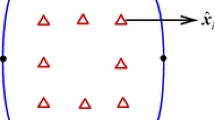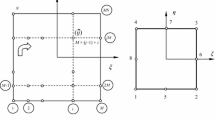Abstract
The singular hybrid boundary node method (SHBNM) is proposed for solving three-dimensional problems in linear elasticity. The SHBNM represents a coupling between the hybrid displacement variational formulations and moving least squares (MLS) approximation. The main idea is to reduce the dimensionality of the former and keep the meshless advantage of the later. The rigid movement method was employed to solve the hyper-singular integrations. The ‘boundary layer effect’, which is the main drawback of the original Hybrid BNM, was overcome by an adaptive integration scheme. The source points of the fundamental solution were arranged directly on the boundary. Thus the uncertain scale factor taken in the regular hybrid boundary node method (RHBNM) can be avoided. Numerical examples for some 3D elastic problems were given to show the characteristics. The computation results obtained by the present method are in excellent agreement with the analytical solution. The parameters that influence the performance of this method were studied through the numerical examples.
Similar content being viewed by others
References
Lucy L B. A numerical approach to the testing of the fission hypothesis[J]. Astronomic Journal, 1977, 18(12):1013–1024.
Belytschko T, Lu Y Y, Gu L. Element-free Galerkin methods[J]. International Journal for Numerical Methods in Engineering, 1994, 137(2):229–256.
Mukherjee Y X, Mukherjee S. The boundary node method for potential problems[J]. International Journal for Numerical Methods in Engineering, 1994, 40(5):797–815.
Zhang J M, Yao Z H and Li H. A hybrid boundary node method[J]. International Journal for Numerical Methods in Engineering, 2002, 53(5):751–763.
Zhang J M, Yao Z H. The meshless regular hybrid boundary node method for 2D linear elasticity[J]. Engineering Analysis with Boundary Elements, 2003, 27(3):259–268.
DeFigueredo T G B, Brebbia C A. A new hybrid displacement variational formulation of BEM for elastostatics[C]. In: Brebbia C A, Conner J J (eds). Advances in Boundary Elements. Computational Mechanics Publication, Southampton, 1989, 1(1):47–57.
Atluri S N, Kim H G, Cho J Y. A critical assessment of the truly Meshless Local Petrov-Galerkin (MLPG), and Local Boundary Integral Equation (LBIE) methods[J]. Computational Mechanics, 1999, 24(2):348–372.
Author information
Authors and Affiliations
Corresponding author
Additional information
Communicated by WANG Cheng
Project supported by the Program of the Key Laboratory of Rock and Soil Mechanics of Chinese Academy of Sciences (No.Z110507)
Rights and permissions
About this article
Cite this article
Miao, Y., Wang, Yh. Meshless analysis for three-dimensional elasticity with singular hybrid boundary node method. Appl Math Mech 27, 673–681 (2006). https://doi.org/10.1007/s10483-006-0514-z
Received:
Revised:
Issue Date:
DOI: https://doi.org/10.1007/s10483-006-0514-z
Key words
- three-dimensional elasticity
- moving least squares
- meshless method
- modified variational principle
- singular hybrid boundary node method




